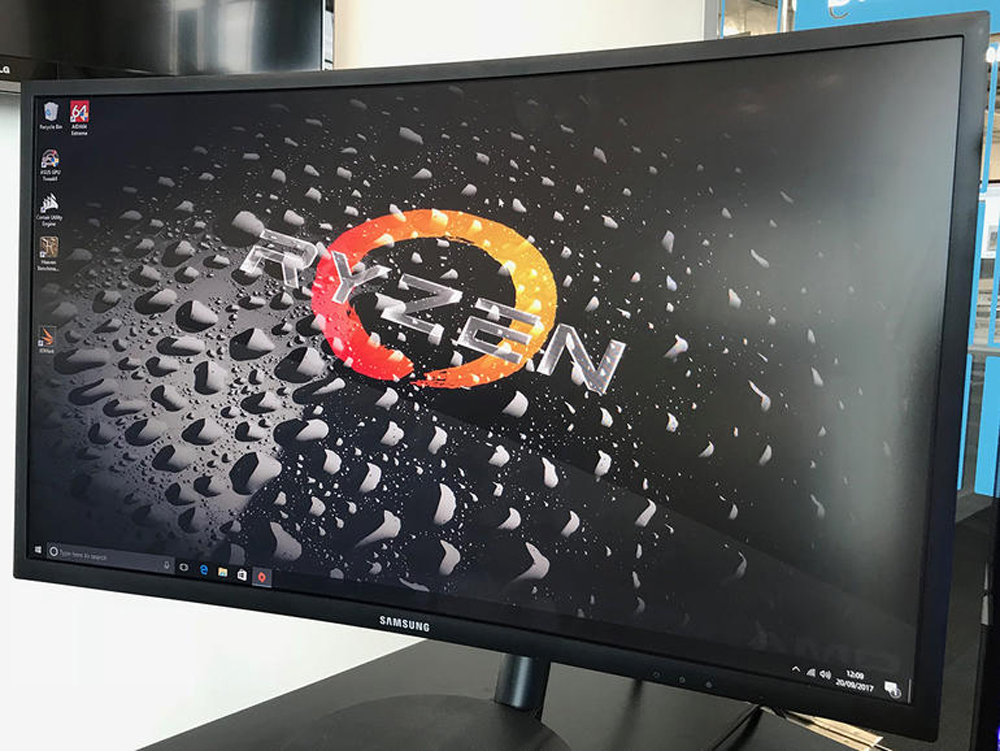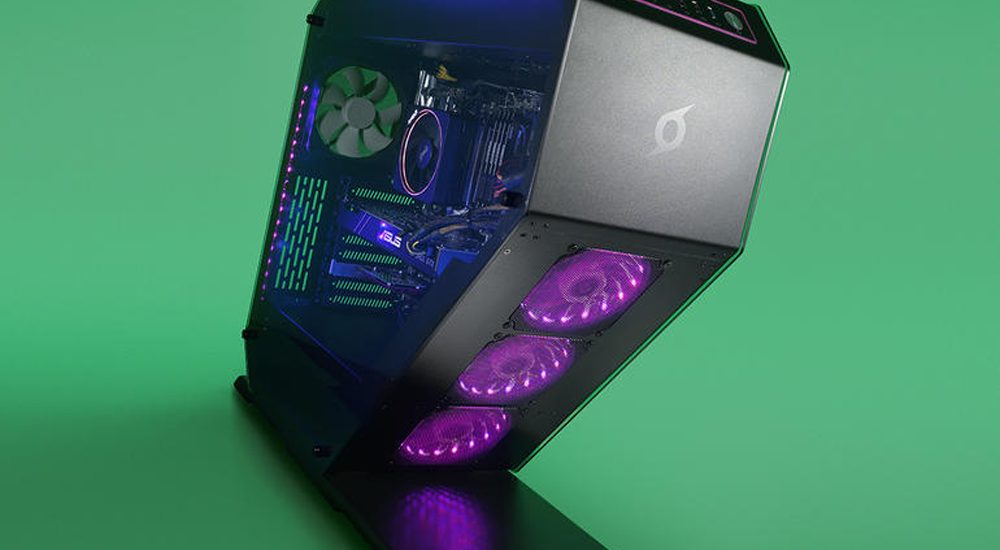See-through side panels. Multi-colour LED fans. A chassis that could have been plucked straight out of a Michael Bay Transformers movie.
The Stormforce Geo is about as “gaming PC” as gaming PCs get.
Don’t be distracted by the bright lights and alluring hardware peeking out from behind the glass, though. This is as much a test of AMD’s new silicon as it is of a madder-than-Charles-Manson gaming PC.
Y’see, Ryzen is the first truly competitive chip out of AMD for what feels like years, taking on Intel’s mighty Core i-series in the race to be the go-to CPU for gamers.
You’ll find one at the heart of this machine, and it’s more than capable of chewing up just about any game you can throw its way.
DESIGN & BUILD



Before we get stuck into the hardware inside, like a particularly oversized and expensive Kinder Egg, it would be remiss to ignore the Geo’s ginormous, eye-catching case. So we’ll start with that.
The towering behemoth has an asymmetric shape, with the top half of the case jutting out much further than the bottom half – sort of like Pride Rock from the Lion King, only covered in LED fans. Three of ‘em, to be exact. The entire system stays impressively quiet, though. You’ll barely hear it in an office, and even at home it’ll stay whisper quiet until you hit the graphics card hard with a game.
It sits on a heavy plinth to keep the thing from toppling over, so it’s not like you’re saving any desk or floor space with this design – but if unique looks are important, this will definitely serve you well.
Both sides are covered in tempered glass, tinted slightly to tease the hardware hiding inside. It works on the left side, showing off juicy kit like the glowing AMD CPU cooler, beefy Asus graphics card, and Kingston HyperX memory modules. An LED light strip bathes the whole thing in colour-changing hues – it’s either gorgeous or gauche. I’m firmly in the former camp.
Around the back, though, you’re just seeing cables behind the glass – not very exciting, really.
Up top, the front I/O panel (which of course lights up too) has a dedicated button for mixing up the LED colours, next to the usual smattering of USB and audio ports.
The whole thing is built of steel, so weighs a ton, but ensures you won’t be troubled by vibrations or rattling coming from the components. Stormforce has done a decent job with cable management too, hiding most wires from view when peeking in through the side panel.
HARDWARE & COMPONENTS



OK, now on to the good stuff. Undoing the six thumbscrews holding that glass side panel on reveals AMD’s 1800X Ryzen 7 CPU, sitting pride of place in an Asus X370 motherboard – which (of course) has it’s own LED lighting.
It’s an eight core, sixteen thread chip running at 3.6GHz, and with enough juice left in the tank to crank all the way up to 4GHz when temperatures allow.
You’d need to break out the technical manual to explain all the differences between Ryzen and Intel’s Core CPUs, but basically you get more cores on AMD for slightly less cash, or higher clock speeds on Intel for slightly more. How does that translate into performance figures? Read on to the next section.
Ryzen isn’t even AMD’s top-end chip now, either. That would be Threadripper, where the clue really is in the name. Think more cores, higher clock speeds, and even more performance. But back to Ryzen for now.
Stormforce has used AMD’s reference heatsink to cool the chip (which admittedly has some very funky LED lights on it), but I can’t help thinking a water cooling setup would have been better in a showpiece system like this. Not that temperatures are a problem, mind.
You’ll find an Asus-branded Nvidia GeForce GTX 1080ti graphics card below the CPU cooler – not an AMD card, because they weren’t on sale when this system was built. You could make the switch to an RX Vega GPU before you buy, if you wanted an all-AMD system.
Look closely and you’ll spot the 512GB NVMe SSD slotted directly into the motherboard, sandwiched between the CPU and GPU. NVMe (or Non-Volatile Memory Host Controller Interface Specification, if you’re feeling fancy) is the technical term for “goes like stink” – this WD drive can manage 2050MB/s file reads and 800MB/s writes, which is significantly quicker than a SATA SSD, and miles faster than a traditional hard disk.
There’s one of those too, though: a 3TB model for storing all your games, documents and multimedia files on. It sits at the top of the case, hidden from view, and with room for three more full-size disks should you want to add more storage later.
Although you can spec the Geo with whatever peripherals and accessories you want, it come to us supplied with a curved, 144Hz Samsung monitor and a full selection of Corsair’s RGB-illuminated gaming gear. And yes, even the mouse mat lights up.
With a bit of software tinkering, you can have the entire setup glowing in unison. Because, let’s face it: when it comes to gaming, you can never have too much LED lighting.
PERFORMANCE



Eight cores and 16 threads make Ryzen a multi-tasking monster. Add in the 32GB of DDR4 memory on-board and there’s no excuse for sticking to one program at a time.
This pairing will make short work of any video editing, and is especially adapt at online streaming – great if you’re a regular on sites like Twitch. In fact, any programs that are optimised for multiple cores will absolutely lap up Ryzen’s power. In Cinebench, a 3D rendering tool, it goes beat-for-beat with the equivalent Intel processor.
It’s not quite the same success story in single-threaded programs, where Intel again takes the lead, but by a much smaller margin than it did in previous years.
Gaming is what I’m most interested in, though, and it’s here that Ryzen starts to show its limits. With the same GeForce GTX 1080Ti graphics card, an Intel machine produced slightly higher frame rates in most of the games I tried – if not by much. We’re talking a 10-15% variance, and everything I tried was perfectly playable, but Intel undoubtedly takes the lead.
The problem here? The 1080p Samsung monitor supplied with the system. At Full HD resolutions, the CPU is the bottleneck, unable to deliver enough data to the GPU to keep those frame rates as high as possible. Titanfall 2 was still buttery smooth at well over 90fps, but the Intel machine could do a slightly better job.
Swap out the screen for a 1440p panel or even a 4K display, though, and Ryzen closes the gap. There was very little difference between Intel and AMD on The Witcher III, and 2016’s Doom reboot was as bone-crunchingly violent as ever.
If your PC is used solely for gaming at 1080p resolutions, then, a higher-clocked Intel quad-core chip, like an i7-7700K, is still probably your best bet right now – it just plays nicely with more titles. 1440p and 4K gamers should see more of a benefit, though, because CPU speeds are less of an issue once you’re pushing around so many pixels. That’s when the graphics card really comes into its own, and the GTX 1080Ti is more than capable of keeping frame rates high on a UHD display.
Developers are catching up to the hardware, too, and eventually Ryzen’s higher number of cores should swing things back into the AMD camp. You could also step up to Threadripper now, too, which closes the gap even further.
One last thing about this system: it’ll overclock like a beast, too. I managed 4GHz on the standard air cooler, with temperatures never getting higher than 73 degrees even when stress-testing with demanding number-crunching benchmarks.
Stormforce Geo Verdict



There’s no denying the power on tap here: the combination of Ryzen CPU and Nvidia graphics card meant the Geo pumped out high frame rates in every game I tried.
The multi-threaded CPU is already starting to show off its potential, as more and more programs are making the most of those extra cores, and AMD seems to have successfully narrowed the performance gap between it and Intel – without needing you to remortgage your house to get hold of the silicon, too.
It doesn’t quite outpace the equvalent Intel chip (you’ll need a more expensive Threadripper for AMD’s answer to the mighty Core i7) but it’s the most competitive CPU AMD has pumped out in years.
The Geo feels a bit top-heavy, though, and not just because of that funky-looking case. It’s got a killer CPU, but sticks to the stock air cooler – surely water cooling wouldn’t have been too much to ask in a system this expensive. Sure, temperatures are fine on air, but when the rest of the system is such overkill, it feels like Stormforce missed a trick.
You can of course build something similar yourself for less cash – but not everyone is a whizz with a screwdriver and a pot of thermal paste, are they? If you want a gaming PC that’ll cope with anything you throw at it for at least the next five years, this will absolutely survive the test of time – even if right now it isn’t the absolute performance champ.
Tech Specs
- CPU-AMD Ryzen 1800X
- MEMORY-32GB DDR4 RAM
- GPU-Nvidia GeForce GTX 1080ti
- STORAGE-512GB PCI-E SSD, 3TB hard disk
- DIMENSIONS-TBC
Sоurсе: stuff.tv




































